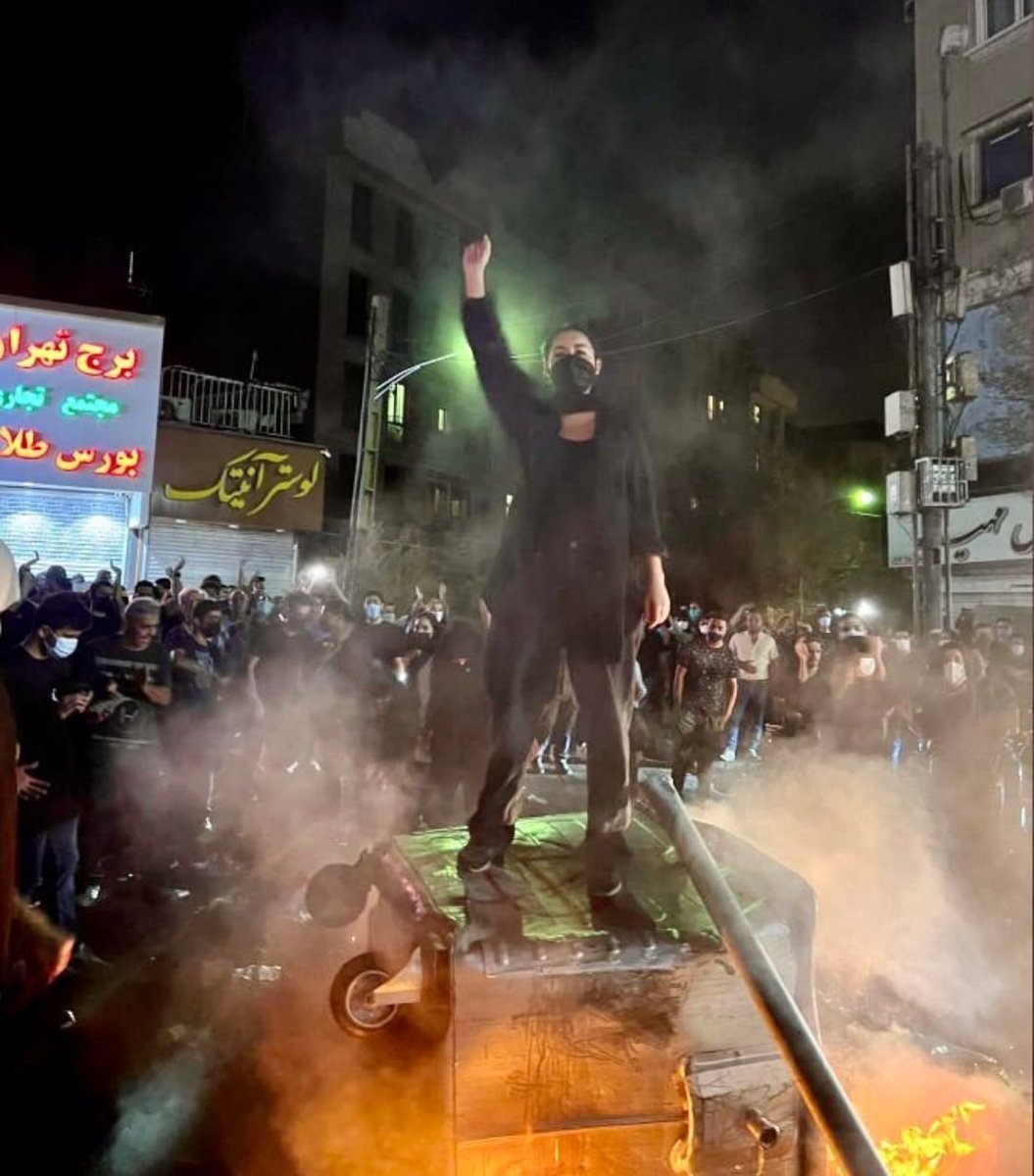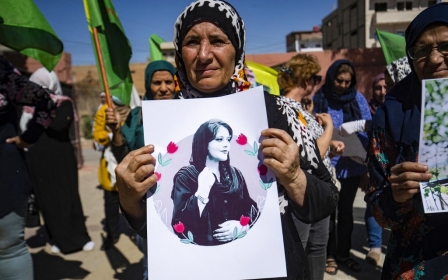Iran protests: Exiles and the West should let Iranians find a solution
There will be many iconic images from the latest wave of Iran protests - just about everyone has a camera phone.
But one in particular sums up this explosion of anger: a young woman, fist aloft, standing on an overturned trash can, fire and smoke around her. It's powerful, but not simply for its artistic content.
This young woman is standing in the heart of Tehran, facing down a state that could literally end her life in an instant. This woman is leading a revolution – her own. Young Iranians have taken to the streets in dozens of cities across Iran, burning their hijabs, chanting "woman, life, freedom".
Whatever is happening in Iran, call it a feminist revolution, an uprising, or a brief explosion of anger, it is indigenous and organic
Others are protesting quietly - quite literally, walking down the street in whatever they want to wear, or going for a drive to create traffic jams, which make it harder for police and the Basij (religious militia) to manoeuvre.
New MEE newsletter: Jerusalem Dispatch
Sign up to get the latest insights and analysis on Israel-Palestine, alongside Turkey Unpacked and other MEE newsletters
They are the newest generation in a movement that dates back to 1905 and the struggle for democratic rights. This movement did not suddenly erupt in 2022 and has existed in some form for more than a century.
Most recently, since 1999, mass protests have erupted in Iran every 10 years, almost like clockwork. The protests have traditionally lasted weeks and always started with very specific grievances, such as a newspaper ban in 1999, voter fraud in 2009 and fuel price hikes in 2019.
It usually took time for those demands to spiral into chants against the establishment or even calls for its collapse. In 2022, there is no grace period. Almost as soon as protesters hit the streets after the death of Mahsa Amini, there were demands for the supreme leader to step down and to dismantle the system. The fuse is short.
But make no mistake, the turmoil in Iran is a self-made crisis, and as such there must be a self-made solution, not one from monarchist exiles, Twitter warriors or self-aggrandising foreign-based activists, wrapped comfortably in their own personality cults.
An indigenous uprising
Whatever is happening in Iran, call it a feminist revolution, an uprising, or a brief explosion of anger, it is indigenous and organic. Regardless of whether the protesters' demands come to fruition or not, this is their movement and theirs alone.
This crisis was made inside Iran, specifically because the system, the Islamic Republic itself, has not only refused to evolve and reform, but has actively sabotaged any attempts by its populace to do so.
Despite what many exiles and western media outlets spew, until recently the majority of Iranians inside Iran were not calling for the collapse of the Islamic Republic of Iran nor any kind of violent overthrow. They were demanding, very simply, reform.
This is evident in the high turnout for the presidential elections in 2013, when 72.94 percent of the voting population cast its ballots, and again in 2017 (73.3 percent turnout). In the latter election, incumbent Hassan Rouhani won in a landslide, with voters overwhelmingly rejecting his main rival, and the establishment favourite, Ebrahim Raisi. It was not simply an election. It was a referendum on the future of Iran, the consequences of which voters understood fully.
Despite the landslide victories handed to reform-oriented candidates - Mohammad Khatami being the first - the establishment, which includes the supreme leader, a core group of hardliners and elements of the Revolutionary Guard Corps, has thwarted the wishes of the people.
In fact, Raisi, who was so evidently unpopular, could only win the 2021 presidential election because just about any candidate of value was banned from running against him. Turnout was the lowest in the republic’s history at 48.8 percent. But the election also broke another record: 14.07 percent of ballots were invalid protest votes and outnumbered the ballots for any single runner-up. In effect, the people polled second.
Raisi is now, of course, president. And all branches of the Iranian establishment, elected and unelected, are in the hands of hardliners. What emerged has been a watershed moment of entrenchment.
Raisi's job is also easier than his predecessors. Unlike reformist or pragmatist governments, the president is not constantly undermined by hardliners, state-controlled press, or unelected cartels, nor are his ministers regularly dragged before parliament with threats of impeachment.
Thus, what we are seeing now is the true essence of the modern Islamic Republic - not its original ideation under Khomeini, when there were, albeit limited, political parties and considerable factional debate, but its contemporary, much more restrictive form.
The TikTok generation
The current system has left no room for debate or reform. A system that rejects the wishes of the majority of its citizens, as in the aforementioned elections, has destroyed its own legitimacy. And legitimacy is at the core of what is happening right now.
As I noted in my book, most protesters in the streets are youths in their late teens and 20s struggling to take charge of their destiny. They are the so-called TikTok generation, who are more interested in Netflix's Stranger Things than the revolution that led many of their parents into the streets in 1979.
But they are also fearless and seemingly unencumbered by the disappointment of previous failed uprisings, such as that of 2009, which left millions of their contemporaries apathetic and hopeless.
Arguably, because the establishment has aborted the reform movement - and perhaps even worse, its own leaders made themselves irrelevant through acquiescence - these protesters are leaderless and unlikely to succeed in any meaningful way.
Conversely, hardliners and establishment supporters have long relied on a similar popular uprising for legitimacy: 1979. Most Iranians have at one point or another, supported the revolution, specifically its core aim - independence from foreign interference.
Meanwhile, western sanctions, maximum pressure and anti-Iran hysteria have rather perversely only made it easier for the Islamic Republic to justify its existence and crackdowns, and, as we are seeing with the lack of outside technological cooperation, made it easier to cut Iranians off from the internet and the rest of the world.
Point of 'no return'
The 1979 revolution and whatever that means in 2022 can no longer hold people together in the face of widespread disenfranchisement, corruption, nepotism and brutality.
Indeed, thousands of Iranians who fought against a dictator and for a revolution lost faith in what they did long ago for various reasons. And now, for millions more young Iranians born well after that event, this is their point of no return.
It didn't have to be this way. What could have held people together was a path forward. A system and a leadership willing to bend with the times; to negotiate, listen, and allow regular Iranians back into the decision-making process. Instead, what we are witnessing is an establishment that would rather arrest and kill than compromise. Because in a state where legitimacy is being questioned, compromise is capitulation.
As one young Iranian told me years ago, in the face of another uprising: "The problem is; we are willing to die for what we believe. But they are willing to kill."
The views expressed in this article belong to the author and do not necessarily reflect the editorial policy of Middle East Eye.
This article is available in French on Middle East Eye French edition.
Middle East Eye delivers independent and unrivalled coverage and analysis of the Middle East, North Africa and beyond. To learn more about republishing this content and the associated fees, please fill out this form. More about MEE can be found here.







